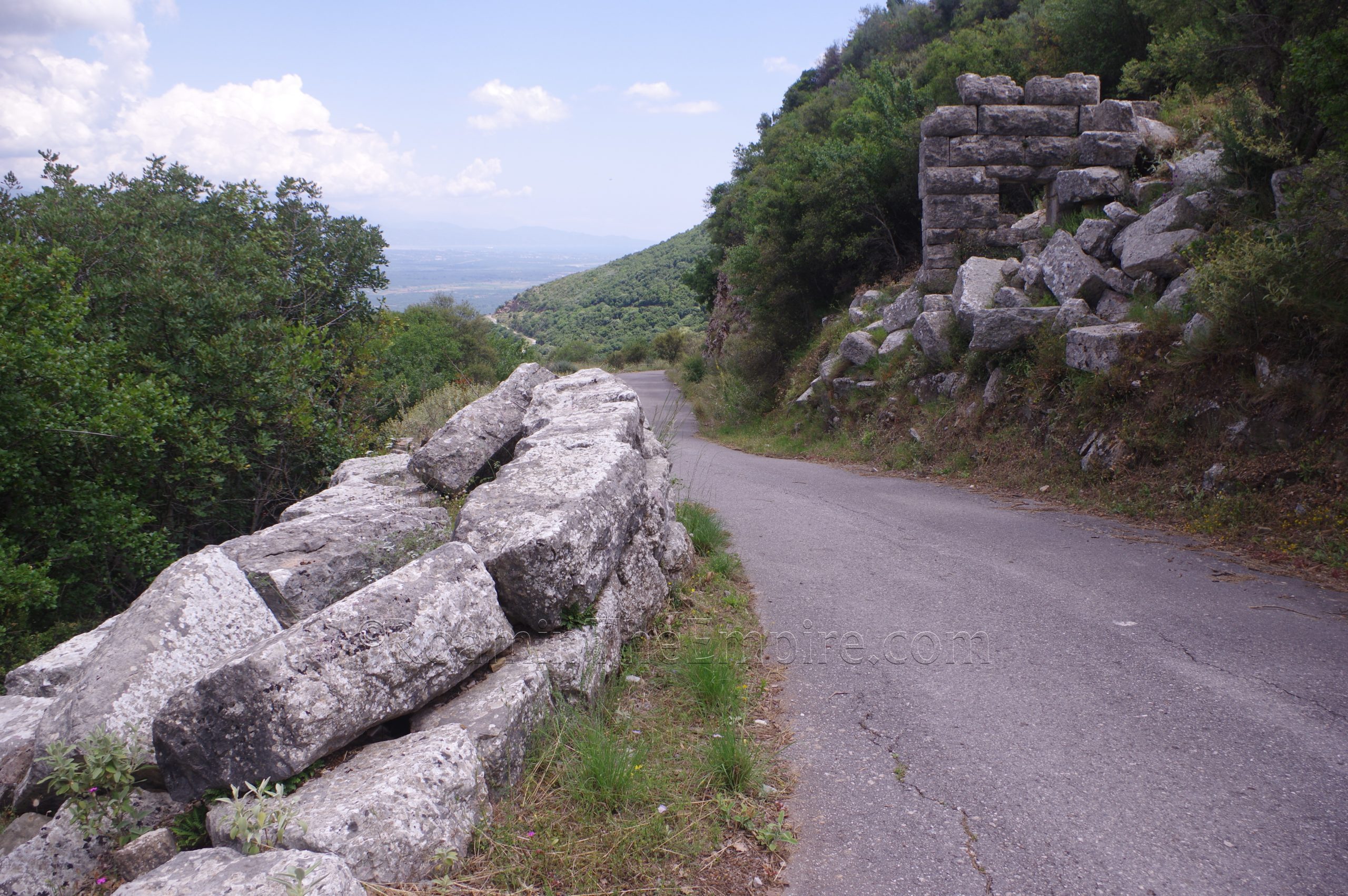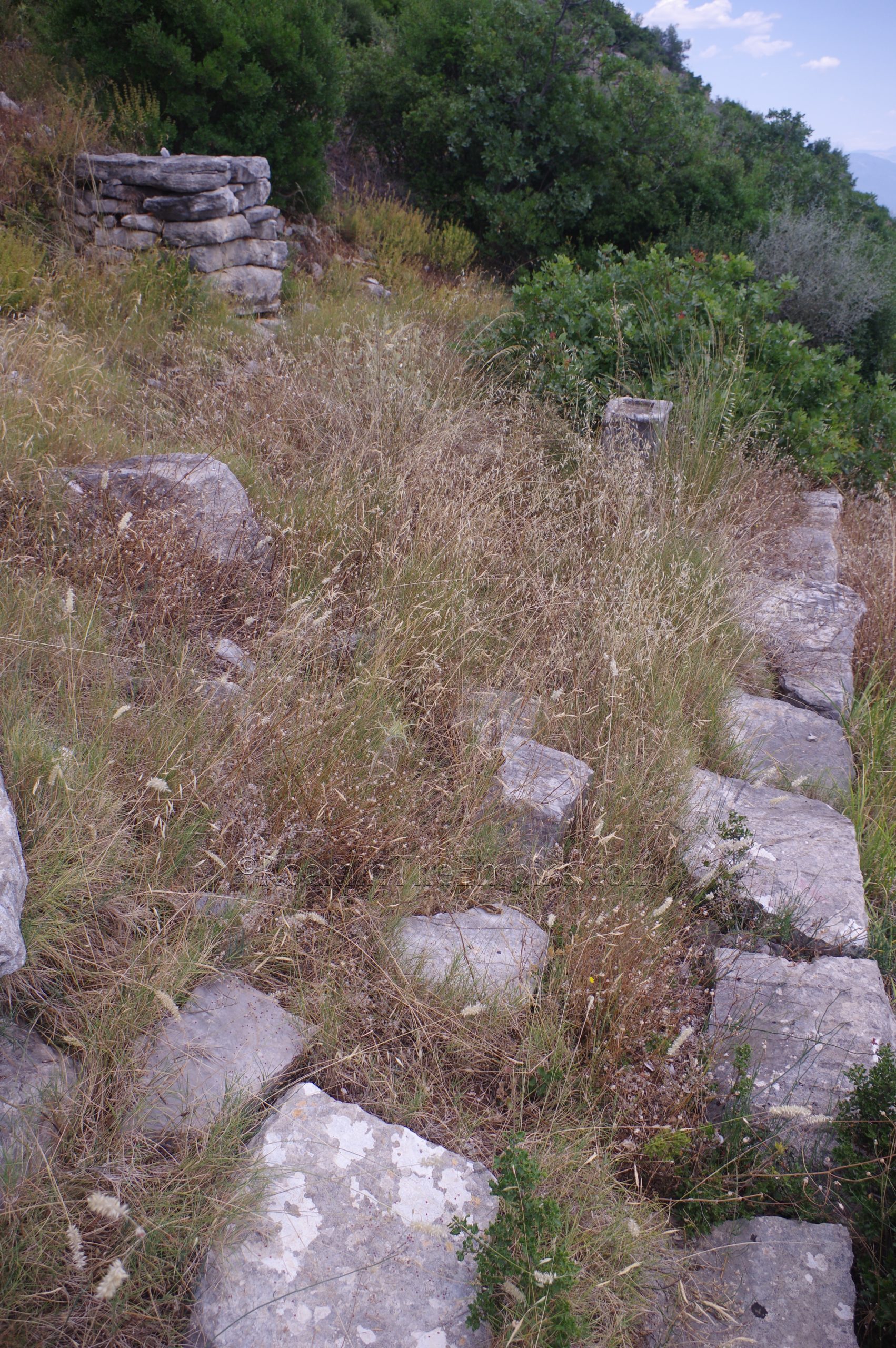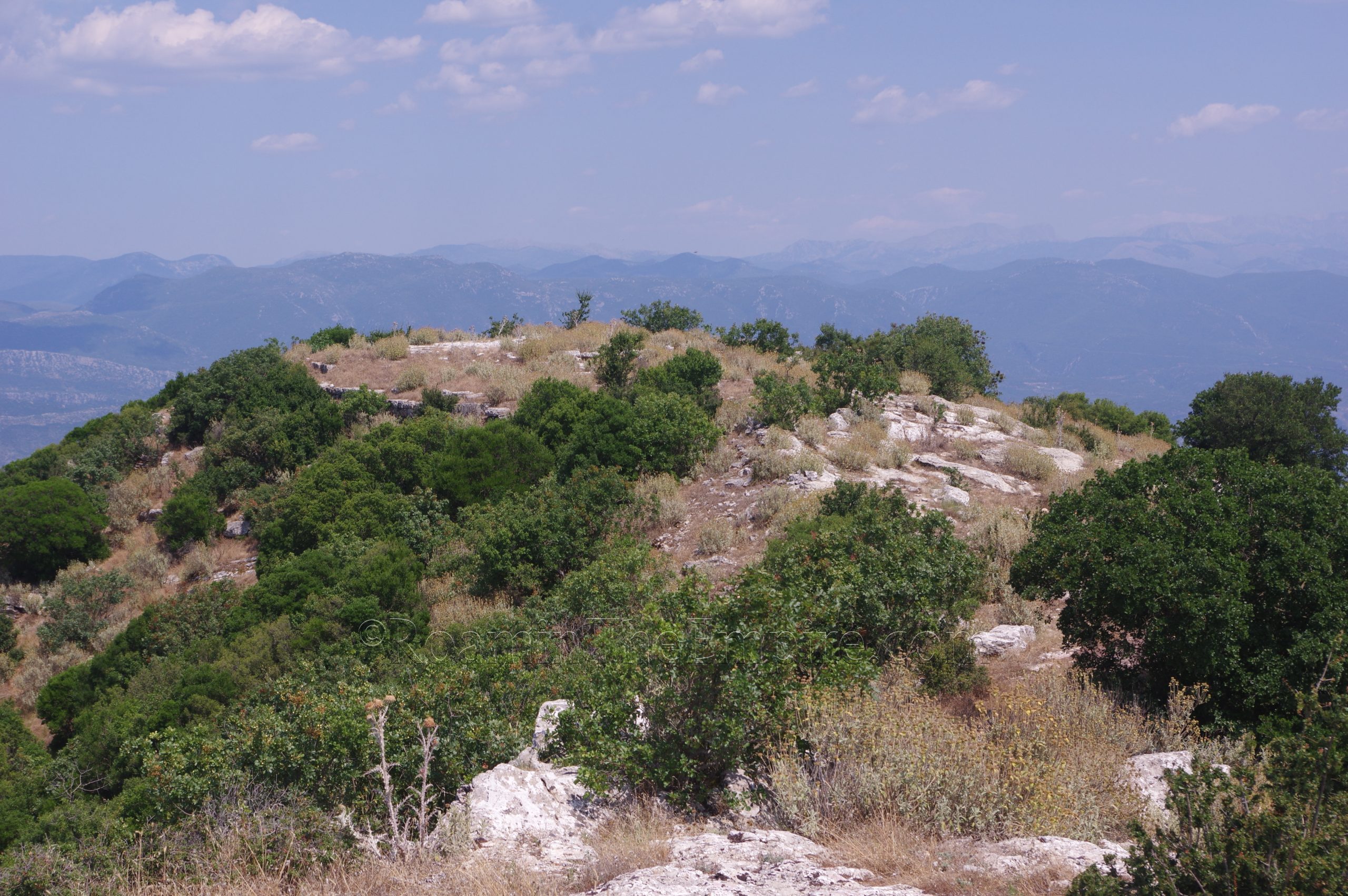
Continued From Messene, Achaea – Part VII
Continuing along the road another kilometer and few minutes of driving (not through the gate) is another well-preserved section of the fortifications. There is no gate here, but rather the wall was destroyed to allow the passage of the road. On both sides of the road, significant portions of the walls are preserved. There’s an area for parking on the south side of the road, just inside the walls. There are about 270 meters of walls running up the hill to the north of the road. There are two fairly well preserved towers and one mostly ruined tower. Beyond the last tower, which marks the point at which the walls change direction and head west toward the Arcadian gate, remnants of the wall are visible. But beyond this point, the walls is mostly debris, rather than intact sections of wall.
The walls that run to the south of the road are on a more accessible level ground. The walls are preserved pretty well for about 240 meters from the road, and beyond that, remnants are visible for a little father, but again, are mostly debris. Along this part of the walls are three towers, including one that abuts the south side of the road. The fortifications are in a pretty good state of preservation in many places, though not intact to an especially considerable height. The tower closest to the road is not in great shape, but the other two are. The middle tower has a circular face, and the steps up to it are intact, so you can actually enter the tower through an intact doorway. Like the Arcadian gate, this area is open access and there are no sort of restrictions.
Heading back the couple kilometers toward Mavrommati, in the center of town is the Klepsydra Fountain. There’s a parking square about 100 meters farther to the east. Though much of what is now visible of the fountain dates to later periods, it does incorporate ancient material. Particularly the channels and cisterns associated with the fountain. Evidence of a sanctuary dedicated to Acheloos has been found in the adjacent Agios Ioannis Riganas church to the west. The sanctuary was likely not functioning by the time of Pausanias, as he makes no mention of it when describing the fountain located along the road to the peak of Ithoma. It is the Klepsydra fountain that fed into the Arsinoe Fountain in the main settlement. The name Klepsydra, according to Pausainas, derives from the Greek klepto, to steal, in reference to the theft of Zeus by the Kouretes, and part of the the Messenian tradition that Zeus was raised on Ithome.

A turnoff on the road just to the east of the fountain leads on a somewhat precarious in parts, but otherwise perfectly traversable road uphill through Mavrommati and to the roads that lead up to Ithome. This isn’t the same road one likely would have come to get to Messene from the highway, but it does lead back there eventually. Continuing on this road for about 5 minutes and 1.5 kilometers eventually leads to a ridge that overlooks the valley to the east and the road turns south to head back downhill. At his bend, where there is a small parking area next to a roadside shrine, are the remnants of the Laconian gate, the gate from which the road toward Laconia and Sparta originated.
The gate itself has actually been destroyed by the construction of the modern road. There’s a bit of the wall on the east side of the road, just past the parking spot. On the other side of the road, a few meters down, are the remnants of the wall with a small window-like feature similar to those in the upper parts of other towers. Back by the parking area another part of the wall as it heads up toward the peak of Ithome. There’s actually two circuits of walls in this area. There is this course that runs across the road, and then another course along the ridge to the west of the road, running parallel with the road. It’s possible to get up to the walls that run along the ridge, but the access is not great and the walls are pretty fragmentary (but definitely still identifiable). A little bit of these can be seen on the south side of the road about 30 meters back from the turn in the road. There are also some fragmentary remains of the walls running up the mountain north of the road toward the peak. A hiking path to the monastery and peak starts at the little parking area, which goes by some of the remains of the walls. They also skirt the road up to the top of Ithome at a few points.

On Mount Ithome, there are a series of 3 identified sanctuaries with visible remains. They are accessible via a dirt road that starts up the mountain about 230 meters back along the road toward Mavrommati. When I visited in June (and again in July) the road was in pretty good condition. I didn’t drive up it the first time because it looked like there was the possibility of rain and I wasn’t sure how the road would pan out; if it would get worse and whether there would be any room to turn around if it got worse. The second time I drove up 2.5 kilometers of the total of about 3.3 kilometers to the top before I decided that the road got a little steeper than I was comfortable with in the car I had. But honestly the road up the rest of the way was still wide enough and in decent enough condition up until the very last part. That being said, it’s on the slope of a mountain, so I imagine the condition of the road can vary greatly from season to season and year to year. I’d certainly recommend exercising caution if using the road in a vehicle. It’s fairly straightforward hiking on foot, but again is about 3.5 kilometers walking to the peak (including a couple hundred meters that is definitely not drivable). Though, if walking (at least in the summer) the giant orb weaving spiders like to run webs across the road and paths on the mountain.
About 550 meters up the road, at the first hairpin turn that kicks back to the east, is the Sanctuary of Artemis Limnatis. There’s a sign, and it’s pretty recognizable off to the south side of the road. There’s even a little are to park at the bend. The identification of Artemis Limnatis is supported by a number of inscriptions found here, though Pausanias mentions a temple to Artemis Laphria on the slope of Ithome with a cult statue sculpted by Damophon. Likely both aspects of Artemis were venerated in the space. Artemis Laphria was apparently picked up from Kalydonia by the Messenians during their exile in Naupaktos and brought back at the establishment of the city. Artemis Limnatis was associated with the manumission of slaves, particularly of female slaves, for which a few inscriptions have been found at the sanctuary.

This sanctuary is fenced off, but can still be seen relatively well from outside. Unsurprisingly, the area is mostly overgrown, though. Dating of the sanctuary is uncertain. Some elements found here date the sanctuary’s establishment as simultaneous with the founding of the city in the early 4th century BCE, while other elements date it slightly later, to the end of the 3rd century CE. On the north side is an Ionic temple, and a few meters to the east of it an associated altar. This may date even later to the 2nd century BCE. There are a few buildings to the south of the temple, one of which may have been an earlier temple, but they’re not very visible between the distance and the vegetation. The only easy viewpoint of the sanctuary is from the north; heavy growth and the topography around the other sides of the sanctuary made it difficult to find a safe path around. Similarly, there are the remnants of a terrace to the south of the temple, believed to have been a fountain, but this area was again inaccessible for the same reasons. There is a small informational sign in English and Greek near the parking area.

A path to the north of the sanctuary leads down to the west into a wash and up out to another sanctuary about 400 meters away. This has been identified as the Sanctuary of Eileithyia and the Kouretes. Eileithyia, a goddess related to childbirth, is mentioned by Pausanias as having a temple with a cult statue in Messene, though he does not disclose the exact location of this temple. The temple that stands here was likely dedicated to the goddess and looks to be in the midst of restoration, though it does not appear as though any work has been done in a while. While the temple is effectively open access, wasps (or hornets) have unfortunately made their home in the many hollow scaffolding bars that surround the building. In this way, it’s difficult to access the temple without risking contact with one of these bars and provoking a response from the wasps.

On a terrace above (north) of the temple is an area that seems to have been dedicated to the Kouretes, daimons that were tasked with protecting the infant Zeus from Kronos. As such, they also had a connection to infancy and childbirth. In the Messenian tradition, the Kouretes rescued Zeus after he was abandoned by Rhea, and brought him to the mountain, where he was washed in the Klepsydra fountain by the nymphs Neda and Ithome and raised on the peak of the mountain which would bear the name of the nymph Ithome. According to Pausanias, water was brought daily from the Klepsydra fountain to the Sanctuary of Zeus Ithomatas at the peak. The retaining wall of the terrace is pretty visible from below and there is a rather precarious staircase leading from the area of the temple up to the terrace. The terrace itself was mostly overgrown, but there were definitely elements visible, such as stone base with a shallow cavity and a scattering of large, worked stone pieces.
Heading back to the main road and trekking up the rest of the road leads to just below the peak of Ithome. When summiting the last part of the trail one passes by a rather large bit of retaining wall on the east side of the trail. At the top there are two distinct areas. Off to the west is the old Voulkano Monastery. Interestingly, Voulkano may derive from Velchanos, an aspect of Zeus linked to his youth. The monastery, which was founded in the 8th century CE, makes use of spolia from the Sanctuary of Zeus. The most apparent example of this is the base of a votive tripod used in the southeastern corner of the building.

The plateau to the east of the trail is where the Sanctuary of Zeus Ithomatas was actually located. Finds here indicate there was a sanctuary to Zeus dating back to at least the 8th century BCE at this location. One of the bronze tripod legs from the 8th century BCE is on display at the museum. A statue of Zeus as a child made by the sculptor Ageladas was apparently brought by the Messenians from Naupaktos, though was likely not the primary cult statue here, which appears to have been a statue of Zeus as the thunderer as depicted on coins of Messene. Games dedicated to Zeus Ithomatas, the Ithomia, were held in the stadium at Messene. One account states that Aristomenes had 300 prisoners of war, including the Spartan king Theopompos, sacrificed to Zeus Ithomatas.
Not much is really left of the sanctuary. The fortifications and terrace walling on the north and eastern sides of the sanctuary are pretty clearly visible, including what would seem to be a tower on the east side. In the central area there are various remnants resembling walls, including some fairly robust walls on the south side of what would appear to be a large square structure or area in the center of the sanctuary.

The Sanctuary of Zeus Ithomatas effectively wraps up the accessible and visible remains of Messene. There’s a lot to see, and seeing everything will very much take a solid day. At the same time, it can definitely be done as a day trip from Kalamata in the summer; the lack of daylight in the winter might cut into the time needed to see the sanctuaries on Ithome, which took a very solid nearly 3 hours including ascent and descent (though you could probably cut a good half an hour to forty-five minutes off that by driving all the way to the end of the road). Messene was easily one of my favorite stops in the summer of 2023
Sources:
Baldassarra, Damiana. “La Famiglia di Damonikos di Messene.”Onomatologos: Studies in Greek Personal Names Presented to Elaine Matthews, R.W.V Catling and F. Marchand (eds.), Oxford: Oxbow Books, 2010.
Bourbou, Chryssa and Petros Themelis. “Child Burials at Ancient Messene.” L’Enfant et la mort dans l”Antiquité I. Nouvelles recherches dan les nécropoles grecques. Le signalement des tombes d’enfants, Ann-Marie Guimier-Sorbets and Yvette Morizot (eds.), Paris: De Boccard, 2010.
Diodorus Siculus. Bibliotheca Historica, 12.44.3, 15.66.
Eck, Werner. “Ein Zeichen Von Senatorischer Identität: Statuenehrungen Für Kaiser Mit Lateinischen Inschriften Aus Messene.” Zeitschrift für Papyrologie und Epigraphik, No. 202 (2017), pp. 255-262.
Grant, Michael. A Guide to the Ancient World: A Dictionary of Classical Place Names. New York: Barnes & Noble Books, 1997.
Kennell, Nigel M. “Cultural History and Memory in the Stadium-Gymnasium Complex at Messene.” American Journal of Archaeology, Vol. 125, No. 4 (October 2021).
Livy. Ab Urbe Condita, 36.3.
Luragji, Nino. “Meeting Messenians in Pausanias’ Greece.” Le Péloponnése D’Épaminondas À Hadrien, Catherine Grandjean (ed.), Pessac, France: Ausonius Éditions, 2008.
Luraghi, Nino. “Messenian Ethnicity and the Free Messenians.” The Politics of Ethnicity and the Crisis of the Peloponnesian League, Peter Funke and Nino Luraghi (eds.), Washington DC: Center for Hellenic Studies, 2009.
Pausanias. Hellados Periegesis, 4.1-33, 4.23.5.
Plutarch. Agesilaus, 34-35.
Plutarch. Aratus, 49-51.
Plutarch. Pelopidas, 30.5, 31.1.
Plutarch. Philopoemen, 12, 18-21.
Polybius. Historiai, 7.10-14, 9.30, 16.13-17, 23.12, 38.16.
Smith, William. Dictionary of Greek and Roman Geography. Walton & Murray, 1870.
Spathi, Maria. “The Sanctuary of Artemis Limnatis in Ancient Messene: An Overview of the Finds Assemblage.” CHS Research Bulletin 11 (2023).
Stillwell, Richard, William L. MacDonald, and Marian Holland. McAllister. The Princeton Encyclopedia of Classical Sites. Princeton, NJ: Princeton U Press, 1976.
Strabo. Geographica, 8.4.6.
Themelis, Petros “Artemis Ortheia at Messene.” Ancient Greek Cult Practice from the Epigraphical Evidence, Robin Hägg (ed.), Stockholm, 1994.
Themelis, Petros. “The Sanctuary of Demeter and the Dioscouri at Messene.” Ancient Greek Cult Practice from the Archaeological Evidence, Robin Hägg (ed.), Stockholm, 1998.
Themelis, Petros. “The Messene Theseus and the Ephebes.” Zona Archeologica. Festschrift für Hans Peter Isler zum 60 Geburtstag, Sabrina Buzzi (ed.), Bonn: Habelt, 2001.
Themelis, Petros. “Roman Messene. The Gymnasium.” The Greek East in the Roman Context, Olli Salomies (ed.), Helsinki: Bookstore Tiedekirja, 2001.
Themelis, Petros. Ancient Messene, Athens: Ath. Petroulakis, 2003.
Themelis, Petros. “Cults on Mount Ithome.” Kernos, Vol. 17 (2004), pp. 143-154.
Themelis, Petros. “The Cult of Isis at Ancient Messene.” Bibliotheca Isiaca, Vol. II (2011), pp. 95-107.
Themelis, Petros. “The Agora of Messene.” Tout Vendre, Tout Acheter. Structures et équipements des marchés antiques, Véronique Chankowski and Pavlos Karvonis (eds.), Pessac, France: Ausonius Éditions, 2012.
Themelis, Petros. “The Theater at Messene: Building Phases and Masons’ Marks.” The Architecture of the Ancient Greek Theatre, Monographs of the Danish Institute at Athens, Rune Frederiksen (ed.), Arrhus University Press, 2015.
Themelis, Petros. “Messene. From the Hellenistic to the Roman City.” Honorary Volume for Stella Drougou, Ministry of Culture and Sports Archaeological Resources and Expropriations Fund, Athens, 2016, pp. 541-556.
Themelis, Petros. “The Sculpture of Messene.” Handbook of Greek Sculpture, Olga Palagia (ed.), De Gruyter, 2019.
Themelis, Petros. “The Sanctuary of Messana: Organization of the Sacred Space.” Côtoyer les Dieux: l’organisation des espaces dans les sanctuaires grecs et romains, Sandrine Huber and William Van Andringa (eds.), Bibliothèque de l’École française d’Athènes, 2022.
Tsivikis, Nikos. “Architectural Planning and Building Practices at the Basilica of the Theater in Messene.” Deltion of the Christian Archaeological Society, Series 4, Volume 39 (2018).
Xenophon. Hellenica, 7.5.5.
Yoshitake, Ryūichi. “Building Phases of the Theatre at Ancient Messene.” Journal of Architecture and Planning, Vol. 84, No. 759 (May 2019), pp. 1259-1269.
Yoshitake, Ryūichi. “The Movable Stage in Hellenistic Greek Theaters. New Documentation from Messene and Comparisons with Sparta and Megalopolis.” Archäologischer Anzeiger, no. 2 (2016), pp. 119-133.
Yoshitake, Ryūichi. “Building Technique of the Theater at Ancient Messene.” Japan Architectural Review, Vol 4, No. 3 (July 2021), pp. 515-532.


